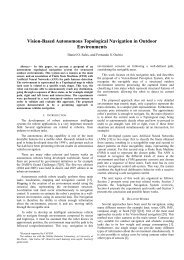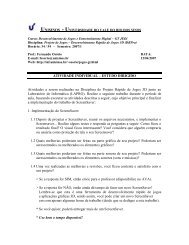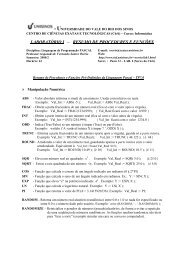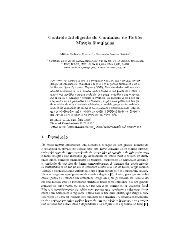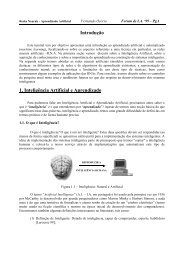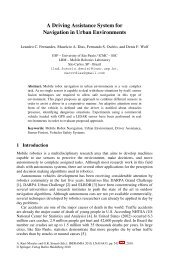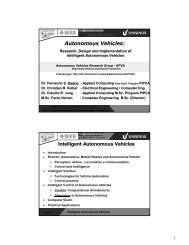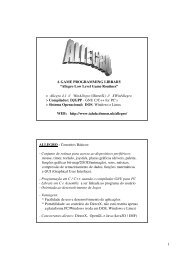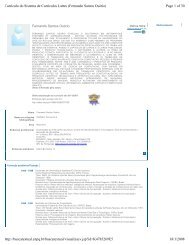Vision and GPS-based autonomous vehicle navigation using ...
Vision and GPS-based autonomous vehicle navigation using ...
Vision and GPS-based autonomous vehicle navigation using ...
Create successful ePaper yourself
Turn your PDF publications into a flip-book with our unique Google optimized e-Paper software.
Figure 2: General outline of the vision <strong>and</strong> <strong>GPS</strong> <strong>based</strong> <strong>autonomous</strong> <strong>navigation</strong> system.<br />
Our approach is <strong>based</strong> on two ANNs. The first identifies<br />
navigable regions <strong>using</strong> a template-<strong>based</strong> algorithm. It<br />
classifies the image <strong>and</strong> identifies the actions that should<br />
be taken by CaRINA. Images are acquired <strong>and</strong> then processed<br />
<strong>using</strong> the ANNs, which identify the road ahead of the<br />
<strong>vehicle</strong>. The value of the azimuth (difference between the<br />
current <strong>and</strong> target positions) as well as a set of values that<br />
correspond to navigable <strong>and</strong> non-navigable regions (free or<br />
obstructed) of the road is obtained. These values are used<br />
as the input of the second ANN, which aims to learn the<br />
control rules (supervised training data) for <strong>vehicle</strong> control,<br />
providing steering <strong>and</strong> velocity values. Several ANN topologies<br />
have been evaluated in order to obtain the minimum<br />
training error. The system is detailed in section 3.<br />
2. RELATED WORKS<br />
Autonomous L<strong>and</strong> Vehicle in a Neural Network (ALVINN)<br />
[11] is an ANN-<strong>based</strong> <strong>navigation</strong> system that calculates a<br />
steer angle to keep an <strong>autonomous</strong> <strong>vehicle</strong> in the road limits.<br />
The gray-scale levels of a 30 x 32 image were used as<br />
the input of an ANN. The original road image <strong>and</strong> steering<br />
were generated to improve the training, allowing ALVINN<br />
to learn how to navigate in new roads. Low resolution of<br />
a 30 x 32 image <strong>and</strong> high computational time are some of<br />
the problems found. The architecture comprises 960 input<br />
units fully connected to a hidden layer by 4 units, also fully<br />
connected to 30 units in an output layer. As this approach<br />
requires real time decisions, this topology is not efficient.<br />
281<br />
Chan et al. [2] shows an Intelligent Speed Adaptation<br />
<strong>and</strong> Steering Control that allows the <strong>vehicle</strong> to anticipate<br />
<strong>and</strong> negotiate curves safely. It uses Generic Self-Organizing<br />
Fuzzy Neural Network (GenSoFNN-Yager) which include<br />
the Yager inference scheme [8]. GenSoFNN-Yager has as<br />
feature their ability to induce from low-level information in<br />
form of fuzzy if-then rules. Results show the robustness of<br />
the system in learning from example human driving, negotiating<br />
new unseen roads. The <strong>autonomous</strong> driver demonstrates<br />
that to anticipate is not always sufficient. Moreover,<br />
large variations in the distribution of the rules were<br />
observed, which imply a high complexity of the system.<br />
Stein <strong>and</strong> Santos [18] system’s computes the steering of<br />
an <strong>autonomous</strong> robot, moving in a road-like environment.<br />
It uses ANNs to learn behaviors <strong>based</strong> on examples from<br />
a human driver, replicating <strong>and</strong> sometimes even improving<br />
human-like behaviors. To validate the created ANNs, real<br />
tests were performed <strong>and</strong> the robot successfully completed<br />
several laps of the test circuit showing good capacities for<br />
both recovery <strong>and</strong> generalization with relatively small data<br />
sets. One of the issues found is the impossibility of validating<br />
network training without testing it with the real robot.<br />
Markelic et al. [5], proposes a system that learns driving<br />
skills <strong>based</strong> on a human teacher. Driving School (DRIVSCO)<br />
is implemented as a multi-threaded, parallel CPU/GPU architecture<br />
in a real car <strong>and</strong> trained with real driving data to<br />
generate steering <strong>and</strong> acceleration control for road following.<br />
Furthermore, it uses an algorithm to detect independently-



